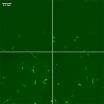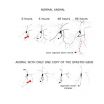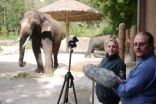(Press-News.org) A research team at the National Institute of Standards and Technology (NIST) has developed a model* for making quantifiable predictions of how a group of cells will react and change in response to a given environment or stimulus—and how quickly. The NIST model, in principle, makes it possible to assign reliable numbers to the complex evolution of a population of cells, a critical capability for efficient biomanufacturing as well as for the safety of stem cell-based therapies, among other applications.
The behavior and fate of cells are only partially determined by their DNA. A living cell reacts to both its internal and external environment—the concentration of a particular protein inside itself or the chemistry of its surroundings, for example—and those reactions are inherently probabilistic. You can't predict the future of any given cell with certainty.
This inherent uncertainty has consequences, according to NIST biochemist Anne Plant. "In the stem cell area in particular, there's a real safety and effectiveness issue because it's very hard to get 100 percent terminal differentiation of stem cells in a culture," she says. This could be problematic, because a therapist wishing to produce, say, heart muscle cells for a patient, might not want to introduce the wild card of undifferentiated stem cells. "Or effectiveness may be dependent on a mixture of cells at different stages of differentiation. One of the things that is impossible to predict at the moment is: if you waited longer, would the number of differentiated versus nondifferentiated cells change? Or if you were to just separate out the differentiated cells, does that really remove all the nondifferentiated cells? Or could some of them revert back?" says Plant.
The NIST experiments did not use stem cells, but rather fibroblasts, a common model cell for experiments. The team also used a standard tracking technique, modifying a gene of interest—in this case, one that codes for a protein involved in building the extracellular support matrix in tissues—by adding a snippet that codes for a small fluorescent molecule. The more a given cell activates or expresses the gene, the brighter it glows under appropriate light. The team then monitored the cell culture under a microscope, taking an image every 15 minutes for over 40 hours to record the fluctuations in cell behavior, the cells waxing and waning in the degree to which they express the fluorescent gene.
Custom software developed at NIST was used to analyze each image. Both time-lapse data from individual cells and time-independent data from the entire population of cells went into a statistical model. The resulting graph of peaks and valleys, called a landscape, says Plant, "mathematically describes the range of possible cell responses and how likely it is for cells to exhibit these responses." In addition, she says, the time analysis provides kinetic information: how much will a cell likely fluctuate between states, and how quickly?
The combination makes it possible to predict the time it will take for a given percentage of cells to change their characteristics. For biomanufacturing, it means a finer control over cell-based processes. If applied to stem cells, the technique could be useful in predicting how quickly the cells differentiate and the probability of having undifferentiated cells present at any point in time.
INFORMATION:
* D.R. Sisan, M. Halter, J.B. Hubbard and A.L. Plant. Predicting rates of cell state change caused by stochastic fluctuations using a data-driven landscape model. PNAS 2012 ; published ahead of print October 30, 2012, doi:10.1073/pnas.1207544109.
Cellular landscaping: Predicting how, and how fast, cells will change
2012-11-01
ELSE PRESS RELEASES FROM THIS DATE:
New discovery shows promise in future speed of synthesizing high-demand nanomaterials
2012-11-01
NORMAN, Okla. – A new discovery by University of Oklahoma and North Carolina State University researchers shows a breakthrough in speeding up the process for synthesizing transition metal oxide nanostructures. What had once taken days can now be accomplished instantaneously.
After previous success using an oxygen-enriched flame to synthesize common nanomaterials, such as carbon nanotubes, nanofibers and fullerenes, OU College of Engineering professor Wilson Merchán-Merchán and his team conducted experiments using the same method to create a new form of nanostructures. ...
Study finds that adding soy to the diet does not affect onset of menopausal hot flashes
2012-11-01
(SACRAMENTO, Calif.) — A team of investigators led by UC Davis found that eating soy products such as soy milk and tofu did not prevent the onset of hot flashes and night sweats as women entered menopause.
Unlike previous studies investigating the relationship between soy and these menopausal symptoms, the current study included a very large population over a long period of time: more than 1,600 women over 10 years.
The article, titled "Phytoestrogen and Fiber Intakes in Relation to Incident Vasomotor Symptoms: Results from the Study of Women's Health Across the Nation," ...
Gene required for nerve regeneration identified
2012-11-01
A gene that is associated with regeneration of injured nerve cells has been identified by scientists at Penn State University and Duke University. The team, led by Melissa Rolls, an assistant professor of biochemistry and molecular biology at Penn State, has found that a mutation in a single gene can entirely shut down the process by which axons -- the parts of the nerve cell that are responsible for sending signals to other cells -- regrow themselves after being cut or damaged. "We are hopeful that this discovery will open the door to new research related to spinal-cord ...
A glimpse into neurosurgical risk prevention and the surgical checklist
2012-11-01
Charlottesville, VA (November 1, 2012). The November issue of Neurosurgical Focus is dedicated to lessening the number and severity of adverse events surrounding neurosurgical intervention for a variety of disorders. Guest editors Alexander Khalessi (University of California, San Diego), James Forrest Calland (University of Virginia), Gabriel Zada (University of Southern California), and Michael Y. Wang (University of Miami Health System) selected 16 articles on systems-based quality improvement for neurosurgical procedures.
The articles are divided into four major subtopics: ...
An elephant that speaks Korean
2012-11-01
An Asian elephant named Koshik can imitate human speech, speaking words in Korean that can be readily understood by those who know the language. The elephant accomplishes this in a most unusual way: he vocalizes with his trunk in his mouth.
The elephant's vocabulary consists of exactly five words, researchers report on November 1 in Current Biology, a Cell Press publication. Those include "annyong" ("hello"), "anja" ("sit down"), "aniya" ("no"), "nuo" ("lie down"), and "choah" ("good"). Ultimately, Koshik's language skills may provide important insights into the biology ...
JCI early table of contents for Nov. 1, 2012
2012-11-01
Congenital diarrheal disorder linked to a mutation in DGAT1
Congenital diarrheal disorders (CDD) are a group of rare intestinal diseases that are caused by genetic mutations. In a study published in the Journal of Clinical Investigation, Robert Farese and colleagues at the University of California, San Francisco, identified a family with two of three children affected by CDD. The affected children both carried a rare mutation in the DGAT1 gene. DGAT1 mediates the formation of triglycerides and is being assessed as a therapeutic target in the treatment of obesity. The study ...
Congenital diarrheal disorder linked to a mutation in DGAT1
2012-11-01
Congenital diarrheal disorders (CDD) are a group of rare intestinal diseases that are caused by genetic mutations. In a study published in the Journal of Clinical Investigation, Robert Farese and colleagues at the University of California, San Francisco, identified a family with two of three children affected by CDD. The affected children both carried a rare mutation in the DGAT1 gene. DGAT1 mediates the formation of triglycerides and is being assessed as a therapeutic target in the treatment of obesity. The study by Farese's group suggests that targeting of DGAT1 could ...
Feedback loop maintains basal cell population
2012-11-01
HOUSTON - (Nov. 2, 2012) – Notch – the protein that can help determine cell fate – maintains a stable population of basal cells in the prostate through a positive feedback loop system with another key protein – TGF beta (transforming growth factor beta), said Baylor College of Medicine researchers in the journal Cell Stem Cell.
"When basal cell homeostasis (or maintenance of a stable population) is disrupted, it may be part of the process that initiates prostate cancer," said Dr. Li Xin, assistant professor of molecular and cellular biology at BCM and a senior author ...
Rice team boosts silicon-based batteries
2012-11-01
HOUSTON – (Nov. 1, 2012) – Researchers at Rice University have refined silicon-based lithium-ion technology by literally crushing their previous work to make a high-capacity, long-lived and low-cost anode material with serious commercial potential for rechargeable lithium batteries.
The team led by Rice engineer Sibani Lisa Biswal and research scientist Madhuri Thakur reported in Nature's open access journal Scientific Reports on the creation of a silicon-based anode, the negative electrode of a battery, that easily achieves 600 charge-discharge cycles at 1,000 milliamp ...
Stem cells show promise for treating infertility in cancer patients
2012-11-01
AUDIO:
This is an audio clip of Deborah Sweet of Cell Stem Cell interviewing Dr. Kyle Orwig of the University of Pittsburgh School of Medicine regarding his recent preclinical study "Spermatogonial...
Click here for more information.
A promising stem-cell-based approach for treating infertility has been successfully demonstrated in non-human primates, as reported in a study published by Cell Press in the November issue of the journal Cell Stem Cell. The preclinical study ...


